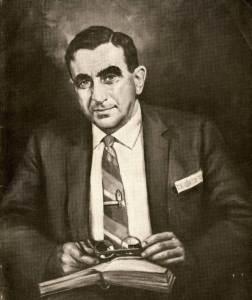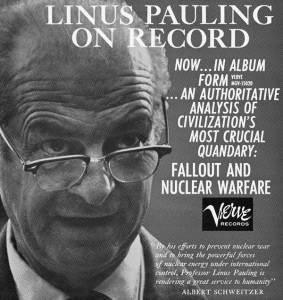
Portrait of Edward Teller by Dmitri Vail. June 1965.
[A detailed examination of the 1958 Pauling-Teller nuclear fallout debate. Post 1 of 5]
Linus Pauling and the Hungarian-American Edward Teller were well-acquainted with one another, both because of their research backgrounds in quantum mechanics and because, by the late 1950s, each was commonly recognized to be one of America’s premier scientists. On February 20th, 1958, the two men came face-to-face in a televised debate about nuclear weapons testing and fallout for the first and only time. Pauling would say afterward that he would never debate Teller again. Later that year, both men also published books that furthered their stances on the topics of nuclear fallout and weapons testing, while simultaneous engaging each other’s views.
World War II came about while both men were at similar places in life. In the mid-1940s, both Pauling and Teller were in the early stages of their careers and were establishing themselves as leaders within their fields of discipline. However, the choices that the two made in the face of war were radically different – as were the projects that they pursued – with both men making decisions shaped by personal motivations and principles.
Although Pauling was asked to work on the Manhattan Project, he declined to do so, partly because he did not want to disrupt his family life, but also out of a desire to continue on his own war work projects uninterrupted. With the onset of war, Pauling made an abrupt shift to support the Allied effort, transitioning his work from a focus on immunology to more practical problems, including finding a substitute for blood serum and devising an oxygen meter for use in submarines and aircraft.
On the contrary, when asked to assist with work on the atomic bomb as part of the Manhattan Project, Edward Teller replied that he could not say no, due largely to his abhorrence of Hitler and Mussolini and the havoc that they were causing in his native Europe. A recent arrival to the United States, Teller felt a strong obligation to protect the freedoms enjoyed by the citizens of his new home, of which he too became a citizen in 1941. Teller likewise believed that it was his job as a scientist to help science progress, a belief that only strengthened post-war, as it became clear that the Soviets had developed their own nuclear weapons in 1949, much earlier than anticipated.
Indeed, World War II and the role that technology played in winning the war both elevated science into the spotlight and expanded capacities for public and political criticism of science. According to Pauling, applied science could be used for evil just as easily as it could be used for good, and sometimes the line between the two was hard to discern.
One outcome of this was that scientists now held greater power in politics, and especially in the military. Nonetheless, after the war ended, many scientists simply aligned themselves with the US government, and its objectives, in part to secure support and funding for their projects. A smaller number, Pauling and Teller included, actively sought to shape government policy with their influence and prestige.

Following the detonation of atomic bombs over Hiroshima and Nagasaki, a long stream of questions and concerns came to dominate the public discourse over nuclear weapons, with many demanding instant action to control the use and further development of these powerful new instruments of war. In the years immediately following the war, Teller agreed with Pauling that a universal government could, and should, control the knowledge that had resulted in the production of a nuclear device – trying to keep the information secret was unscientific and would likely only make the geopolitical situation worse.
Teller continued to believe in this course of action until finally deciding that the solution was not realistic, especially in the face of mounting tensions with the Soviet Union over their rapidly developing technologies. Teller stated publicly that he wished he could side with Pauling’s position that the US could help to maintain peace through international cooperation.
But instead, Teller believed that the US ultimately had to keep the upper hand with respect to nuclear technologies and that doing so necessitated further weapons development. Deterrence, Teller felt, required more weapons, and in order for new weapons to be developed, nuclear tests needed to continue. Teller argued that this was the only path to avoiding a third World War. Pauling, on the other hand, believed that the West needed to learn to get along with the Communists and he sought to include them in his peace activities.
The 1958 debate, and Pauling and Teller’s stances, encapsulate many of the diverse ideas and tensions that surrounded the development and testing of nuclear weapons in the Cold War period. The two scientists approached the dangers of the Cold War and the associated arms race from very different perspectives, due in part to their different disciplinary backgrounds in chemistry and physics respectively. Nonetheless, their tactics and approach were similar in key respects, in part because each man shared an enthusiasm for speaking to large lay audiences.
Both men also sought to educate the American public about the current geopolitical situation and the future of nuclear development, and both strove to present their views in language that the public could understand. Pauling was extremely rational in his thinking and he sought to use his scientific background to educate others so that they could draw their own conclusions concerning nuclear testing and fallout. In this, Teller was similar to Pauling as he too sought to educate the lay public as a means to establish his argument. Both men also believed that it was their duty to educate the public because of their unique positions as scientists, consultants, and citizens.
But the discussion between Pauling and Teller was not merely one of whether or not nuclear weapons should continue to be developed, but ultimately how peace with the Soviet Union could be maintained. For Pauling the dialog was framed as a battle for disarmament that would lead to peace; for Teller, it was deterrence against future Soviet acts of aggression. Both men played on the fears of ordinary Americans, drawing from the very real tensions of the time, and each fought for the attention of politicians who could enact the policies that they, as scientists, could not. As we will see, the result of all this was a sometimes messy battle over calculations, predictions, and interpretations.
